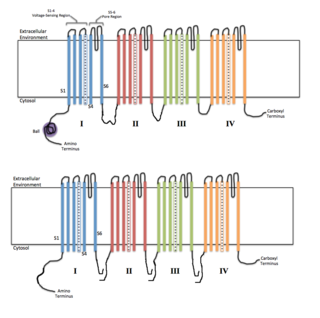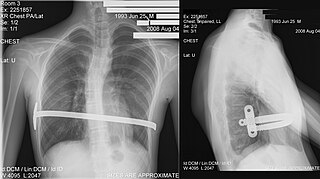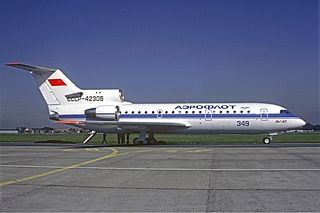This article needs additional citations for verification .(February 2024) |
In anatomy and physiology, segmental stabilizers are the muscles which provide support across joints, as in the multifidus across spinal vertebrae. [1]
This article needs additional citations for verification .(February 2024) |
In anatomy and physiology, segmental stabilizers are the muscles which provide support across joints, as in the multifidus across spinal vertebrae. [1]
Segmental stabilizers align bones, such as the spine, so as to reduce stress during movement. They are primarily enlisted during functional movement and balance training.

A mood stabilizer is a psychiatric medication used to treat mood disorders characterized by intense and sustained mood shifts, such as bipolar disorder and the bipolar type of schizoaffective disorder.

A dorsal fin is a fin located on the back of most marine and freshwater vertebrates within various taxa of the animal kingdom. Many species of animals possessing dorsal fins are not particularly closely related to each other, though through convergent evolution they have independently evolved external superficial fish-like body plans adapted to their marine environments, including most numerously fish, but also mammals such as cetaceans, and even extinct ancient marine reptiles such as various known species of ichthyosaurs. Most species have only one dorsal fin, but some have two or three.
Stabilizer, stabiliser, stabilisation or stabilization may refer to:
Inorganic ions in animals and plants are ions necessary for vital cellular activity. In body tissues, ions are also known as electrolytes, essential for the electrical activity needed to support muscle contractions and neuron activation. They contribute to osmotic pressure of body fluids as well as performing a number of other important functions. Below is a list of some of the most important ions for living things as well as examples of their functions:

A stabilator is a fully movable aircraft horizontal stabilizer. It serves the usual functions of longitudinal stability, control and stick force requirements otherwise performed by the separate parts of a conventional horizontal stabilizer and elevator. Apart from reduced drag, particularly at high Mach numbers, it is a useful device for changing the aircraft balance within wide limits, and for reducing stick forces.

Voltage-gated ion channels are a class of transmembrane proteins that form ion channels that are activated by changes in the electrical membrane potential near the channel. The membrane potential alters the conformation of the channel proteins, regulating their opening and closing. Cell membranes are generally impermeable to ions, thus they must diffuse through the membrane through transmembrane protein channels. They have a crucial role in excitable cells such as neuronal and muscle tissues, allowing a rapid and co-ordinated depolarization in response to triggering voltage change. Found along the axon and at the synapse, voltage-gated ion channels directionally propagate electrical signals. Voltage-gated ion-channels are usually ion-specific, and channels specific to sodium (Na+), potassium (K+), calcium (Ca2+), and chloride (Cl−) ions have been identified. The opening and closing of the channels are triggered by changing ion concentration, and hence charge gradient, between the sides of the cell membrane.

A vertical stabilizer or tail fin is the static part of the vertical tail of an aircraft. The term is commonly applied to the assembly of both this fixed surface and one or more movable rudders hinged to it. Their role is to provide control, stability and trim in yaw. It is part of the aircraft empennage, specifically of its stabilizers.

Hot-melt adhesive (HMA), also known as hot glue, is a form of thermoplastic adhesive that is commonly sold as solid cylindrical sticks of various diameters designed to be applied using a hot glue gun. The gun uses a continuous-duty heating element to melt the plastic glue, which the user pushes through the gun either with a mechanical trigger mechanism on the gun, or with direct finger pressure. The glue squeezed out of the heated nozzle is initially hot enough to burn and even blister skin. The glue is sticky when hot, and solidifies in a few seconds to one minute. Hot-melt adhesives can also be applied by dipping or spraying, and are popular with hobbyists and crafters both for affixing and as an inexpensive alternative to resin casting.

In industrial chemistry, a stabilizer or stabiliser is a chemical that is used to prevent degradation.

The Nuss procedure is a minimally invasive procedure, invented in 1987 by Dr. Donald Nuss for treating pectus excavatum. He developed it at Children's Hospital of The King's Daughters, in Norfolk, Virginia. The operation typically takes approximately two hours.

Image stabilization (IS) is a family of techniques that reduce blurring associated with the motion of a camera or other imaging device during exposure.
Functional movements are movements based on real-world situational biomechanics. They usually involve multi-planar, multi-joint movements which place demand on the body's core musculature and innervation. They may be measured via a functional movement screen.

Originally designed in 1966 by Leonard R Jordan Jr, the steering damper or steering stabiliser is a damping device designed to inhibit an undesirable, uncontrolled movement or oscillation of a vehicle steering mechanism, a phenomenon known in motorcycling as the death wobble. The stabilizer absorbs unwanted energy in the side to side motion allowing the forks and shocks to work properly. Many things can cause a motorcycle chassis to get upset such as slamming on brakes, rough road, and lastly improper setup. An upset chassis can be a great deal of danger for the rider oftentimes resulting in a crash. A steering stabilizer slows those movements down resulting in the rider feeling more comfortable on the motorcycle.

The Kinetic Dynamic Suspension System (KDSS) technology was employed initially in the Lexus GX 470, and subsequently the 200 Series Toyota Land Cruiser. The system was invented and developed by Kinetic Pty Ltd, a small R&D company based in Dunsborough, Western Australia. It optimally adjusts front and rear stabilizers based on a set of interconnected hydraulic cylinders. The interconnection is made up of hydraulic piping and a control cylinder which is located at the frame rail. KDSS, which is fully mechanical, can disengage the stabilizer bars. This system will not engage during normal driving conditions, when hydraulic pressure is equal. In off-road conditions, KDSS activates when it senses that a wheel has dropped.

The scapholunate ligament is a ligament of the wrist.

The inverted row is an exercise in calisthenics. It primarily works the muscles of the upper back—the trapezius and latissimus dorsi—as well as the biceps as a secondary muscle group. The supine row is normally carried out in three to five sets, but repetitions depend on the type of training a lifter is using to make their required gains. This exercise is lighter on the joints compared to weighted rows. The exercise can also be performed with mixed, underhand, or overhand grips with either wide or narrow hand placement. The exercise is also known under various names such as supine row, bodyweight row, Australian pull up or "horizontal pull-up".
Kochouseph Thomas Chittilappilly is an Indian business magnate, writer, investor and philanthropist. He is the founder, chairman and Chief Executive Officer of V-Guard Industries, a chain of amusement parks called Wonderla, a real estate apartment construction venture Veegaland Homes and a wellness park & event hub named Chittilappilly Square. K. Chittilappilly Foundation, a non profit organization founded by him, is engaged in charitable and philanthropic activities.

A camera stabilizer, or camera-stabilizing mount, is a device designed to hold a camera in a manner that prevents or compensates for unwanted camera movement, such as "camera shake".

V-Guard Industries Ltd, stylized as V-GUΛRD, is an Indian electricals and home appliances manufacturer, headquartered in Kochi. The company manufactures voltage stabilizers, electrical cable, electric pumps, electric motors, geysers, solar water heaters, electric fans and UPSs. It was founded in 1977 by Kochouseph Chittilappilly as a small voltage stabilizer manufacturing unit.

Aeroflot Flight 8641 was a Yakovlev Yak-42 airliner on a domestic scheduled passenger flight from Leningrad to Kiev. On 28 June 1982, the flight crashed south of Mazyr, Byelorussian SSR, killing all 132 people on board. The accident was both the first and deadliest crash of a Yakovlev Yak-42, and remains the deadliest aviation accident in Belarus.